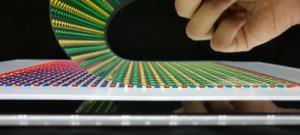
Using ion gradients across hydrogels, researchers have developed a 'soft power' source that can one-day power implantable devices within the human body.
Electric eels have long been model in the study of bioelectrogenesis for researchers, who make use of its acetylcholinesterase and adenosine triphosphate. Inspired by its sudden power release to attack its prey, electric eel model has helped researchers from the University of Fribourg to develop an electric device that can produce 110 volts from gels filled with water, called hydrogels.
The electric eel has three pairs of abdominal organs that produce electricity used to generate two types of electric organ discharges -- low voltage and high voltage. Whenever the fish finds its prey, it opens the ion channels, allowing sodium to flow through, briefly reversing the polarity.
This sudden difference in electric potential generates an electric current similar to a battery, in which "stacked plates each produce an electric potential difference." With some 5,000 to 6,000 stacked electroplaques, an electric eel can produce a shock of up to 860 volts and 1 ampere of current (860 watts) for two milliseconds, which will be deadly for even an adult human, especially for aquarium caretakers and biologists who handle electric eels.
Known as 'soft power' source for biological system's chemical energy needs, the study by Michael Mayer from the University of Fribourg, along with researchers from the University of Michigan and UC San Diego, is set to herald the technology that can one-day power implantable devices.
After observing the electric eel's ability to generate hundreds of volts, graduate student at the University of Fribourg's Adolphe Merkle Institute Anirvan Guha and his colleagues stacked hydrogels full of varying strengths of salt water. As they added more hydrogels, stacked on top of each other, they were able to produce more voltage and it reached up to 110 volts.
Using a printer that deposits little droplets of gel, with the precision and spatial resolution to print an array of almost 2,500 gels on a sheet, the team was able to generate the required 110 volts."Right now, we're in the range of tens to hundreds of microamperes, which is too low to power most electronic devices," said Guha. Microamperes is the basic unit for measuring electrical current.
In the future, the team hopes to develop power sources for implantable devices that can "utilize the (ion) gradients that already exist within the human body," Guha said. "Then you may be able to create a battery which continuously recharges itself because these ionic gradients are constantly being re-established within the body."
Guha, a graduate student at the University of Fribourg's Adolphe Merkle Institute, will present the research during the 62nd Biophysical Society Annual Meeting, to held Feb. 17-21, in San Francisco, California.









